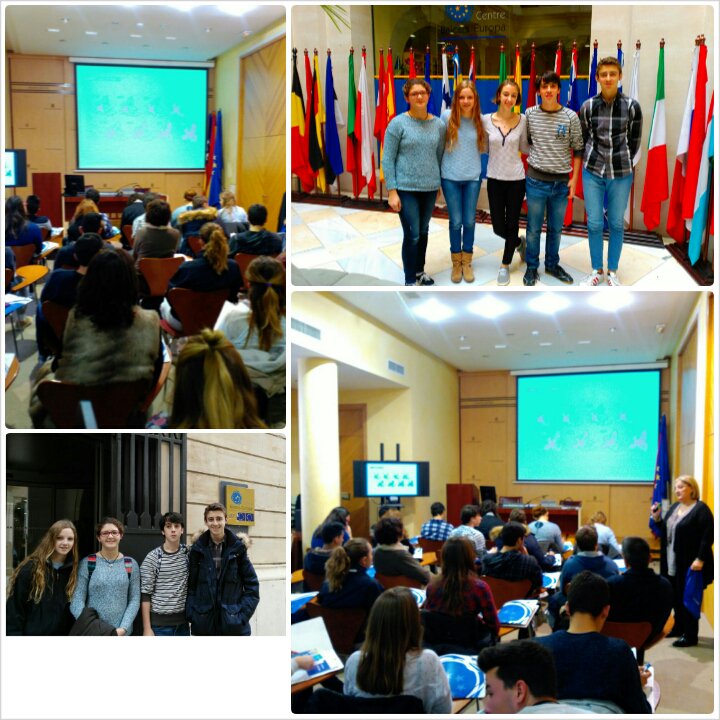"The European Union is an invention for people from people"
We went to the European Balearic Center ("Centre Balears Europa") to attend a lecture about the European Union. We enjoyed it a lot and we learnt a lot of things.
In this post we are going to explain a few things they talked to us about:
First, they talked about the centre where they work. They told us that it has been 30 years since it was opened. It was at the same time as Spain joined what's now the European Union. It works like this: the European Union opens new centres in every country that gets in the EU so that information for the citizens can flow fast and free. There are more than 500 centres in the EU, and 36 of them are in Spain. They give information about studies, jobs, health systems, laws, as well as information about life in different European countries.
They told us that the idea of the EU was because at the end of the Second World War (1945) some problems in Europe were still not solved, and there was a possibility of a Third World War. Because of that, the Treaty of Paris was signed, to use dialogue and no weapons with the objective of preventing a war ever happening again. It was 1951, and the first six countries to join into a European community were France, Italy, West Germany, Belgium, Luxembourg and The Netherlands.
The main goals of the EU are: no war, equality and working on solidarity projects.
According to The Treaty on the European Union, any European country may apply for membership if it respects the democratic values of the EU and is committed to promoting them. The requirements to join the EU are:
There are 24 official languages in the EU. Each time a new country joins the EU, their language is added to the list. Every law has to be written in each language, so each law has been written 24 times. The most spoken language is German, spoken by the 24% of the EU citizens.
Finally, they talked to us about the EU most significant symbols: the EU flag, Europe day, the Euro, the EU motto and the EU anthem.
The EU flag is made of 12 yellow stars on a blue background, and it symbolizes unity. Europe day is on March 9th. It's that day in commemoration of Schuman's speech on 9 May 1950. The Euro was introduced in 1999, but at the time it was non-physical; in 2002 it became physical. The EU motto is United in diversity, meaning that, via the EU, Europeans are united in working together for peace and prosperity, and that the many different cultures, traditions and languages in Europe are a positive asset for the continent. And the anthem is the Ode to Joy by Beethoven, a beautiful composition.
This is just a summary of what they explained to us. We are very thankful for their help!
According to The Treaty on the European Union, any European country may apply for membership if it respects the democratic values of the EU and is committed to promoting them. The requirements to join the EU are:
- having stable institutions to guarantee democracy, the rule of law, human rights and respect for and protection of minorities;
- having a functioning market economy and the capacity to cope with competition and market forces in the EU;
- having the ability to take on and implement effectively the obligations of membership, including adherence to the aims of political, economic and monetary union.
There are 24 official languages in the EU. Each time a new country joins the EU, their language is added to the list. Every law has to be written in each language, so each law has been written 24 times. The most spoken language is German, spoken by the 24% of the EU citizens.
Finally, they talked to us about the EU most significant symbols: the EU flag, Europe day, the Euro, the EU motto and the EU anthem.
The EU flag is made of 12 yellow stars on a blue background, and it symbolizes unity. Europe day is on March 9th. It's that day in commemoration of Schuman's speech on 9 May 1950. The Euro was introduced in 1999, but at the time it was non-physical; in 2002 it became physical. The EU motto is United in diversity, meaning that, via the EU, Europeans are united in working together for peace and prosperity, and that the many different cultures, traditions and languages in Europe are a positive asset for the continent. And the anthem is the Ode to Joy by Beethoven, a beautiful composition.
This is just a summary of what they explained to us. We are very thankful for their help!

Here you have the EU anthem and the EU flag:

You can contact them here:
Centro Balears Europa
Conselleria de Comerç, Indústria i Energia
Palau Reial, 17 baixos
07001 Palma
Tel. 971 784460
Twitter: @cbalears
La visita estuvo genial. Nos hablaron de todo en general: sobre el euro, el himno de la UE, los requisitos que hay que cumplir para entrar en la UE... Una actividad fuera de lo común para ayudar a mejorar un poco más nuestro blog del Euroscola2016. Va chicos, ánimos que nos queda un último empujón!!
ReplyDelete